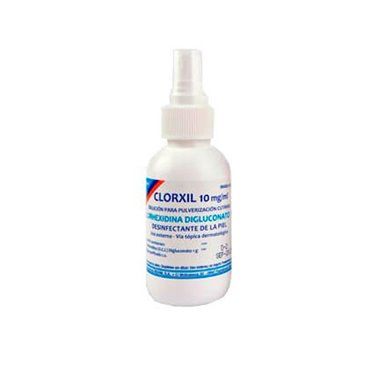Clorxil 10 Mg/Ml Solution For Cutaneous Spray 1 Bottle 50 Ml
Clorxil 10 mg/ml contains chlorhexidine, which is a skin antiseptic. It is indicated for the disinfection of the skin, erosions, small superficial wounds, minor burns and abrasions.
Clorxil 10 mg/ml contains chlorhexidine, which is a skin antiseptic. It is indicated for the disinfection of the skin, erosions, small superficial wounds, minor burns and abrasions.
Clorxil (10 Mg/Ml Solution For Cutaneous Spray 1 Bottle 50 Ml)
ACTION AND MECHANISM
Antiseptic, chlorophenylbiguanidine derivative. It has a relatively broad antibacterial (bacteriostatic) spectrum, with special activity on gram-positives. It is sporostatic. It does not usually induce antimicrobial resistance. It also has fungistatic action (Candida). Its action is relatively slow but it has considerable persistence and residual adherence.
INDICATIONS
-"1% PRESENTATIONS": [DISINFECTION] of wounds, erosions, [BURNS], [SCARAS], preoperative skin disinfection. Disinfection of the navel of the newborn. Barrier against bacterial infection applied to the hands of healthcare personnel (cream).
-"4% PRESENTATIONS": Preoperative disinfection of hands in surgery, antiseptic hand washing in hospitals and pre/postoperative skin antisepsis in patients undergoing surgery.
- "SPRAYER": Disinfection of minor burns, small superficial wounds, cracks and scratches.
POSOLOGY
- 1% PRESENTATIONS : Apply undiluted on the surface to be disinfected, recommending no more than 2 applications/day. Disinfection of the hands of health personnel: pour about 5 ml on the hands, rinse with water and repeat the operation again.
- PRESENTATIONS 4%: Preoperative disinfection of hands in surgery: wet arms and forearms, apply 5 ml and wash for 1 min, cleaning nails, rinse and apply another 5 ml for 2 min, rinse and dry. Antiseptic hand wash in hospitals: wet hands and forearms, apply 5 ml and wash for 1 min, rinse and dry. Preoperative skin antisepsis in patients undergoing surgery: the day before, wash with 25 ml from the face and downwards, paying special attention to the areas around the nose, armpits, navel, groin and perineum. Rinse and repeat washing with another 25 ml, including the hair. Rinse and dry. Repeat the entire process above the next day. Postoperative skin antisepsis in patients undergoing surgery: from the 3rd day after surgery, wash the entire body, excluding the surgical area,
- SPRAY : Apply 1-2 times after washing the wound.
CONTRAINDICATIONS
- Hypersensitivity to the drug.
PRECAUTIONS
- Do not apply in eyes or ears. In case of accidental application, wash immediately with plenty of water.
- The solutions will be stored in bottles with glass, rubber or plastic stoppers (avoid cork ones).
- Dilutions must be renewed weekly. Protect from light and heat.
- Needles and syringes that have been in contact with chlorhexidine solutions should be rinsed in sterile water or saline solution before intraspinal use.
- The treated clothes will not be washed with bleach or with hypochlorites, because it can cause brown coloration in the fabrics, but with household detergents based on sodium perborate.
INTERACTIONS
The action of chlorhexidine is diminished by alkaline pH, presence of organic matter, anionic detergents and tannins.
Elevation of temperature, neutral pH, non-ionic detergents, alcohol and quaternary ammonium salts favor its action.
May interfere with microbiological tests of antibiotics.
PREGNANCY
Animal Safety : Animal studies have not reported fetal risk.
Safety in humans : Adequate and well-controlled studies in humans are not available. precautionary use.
Effects on fertility : No specific studies in humans have been performed.
LACTATION
It is not known whether this drug is excreted in breast milk. No problems have been described in humans, although the possible risk of systemic effects should be taken into account. precautionary use.
KIDS
No specific pediatric problems have been described in this age group.
SENIORS
No specific geriatric problems have been described in this age group.
ADVERSE REACTIONS
Rarely, [SKIN IRRITATION], [DERMATITIS] or [PHOTOSENSITIVITY REACTIONS], in which case discontinue treatment.
Instilled in the middle ear, it can produce [DEAFNESS], so extreme precautions are recommended in case of perforation of the eardrum to avoid injury to the tissues of the inner ear.
Cases of [HEMOLYTIC ANEMIA] have been described after accidental ingestion of clohexidine.
Leaflet Clorxil 10 Mg/Ml Solution For Cutaneous Spray 1 Bottle 50 Ml



